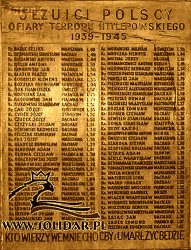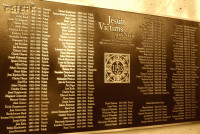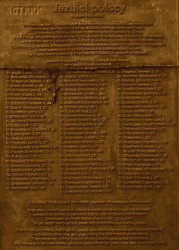Roman Catholic
St Sigismund parish
05-507 Słomczyn
85 Wiślana Str.
Konstancin deanery
Warsaw archdiocese, Poland
full list:
displayClick to display full list

searchClick to search full list by categories
wyświetlKliknij by wyświetlić pełną listę po polsku

szukajKliknij by przeszukać listę wg kategorii po polsku

Martyrology of the clergy — Poland
XX century (1914 – 1989)
personal data
religious status
Servant of God
surname
MALINOWSKI
forename(s)
Michael (pl. Michał)
function
religious cleric
creed
Latin (Roman Catholic) Church RCmore on
en.wikipedia.org
[access: 2014.09.21]
congregation
Society of Jesus SImore on
en.wikipedia.org
[access: 2014.09.21]
(i.e. Jesuits)
diocese / province
Greater Poland‐Mazovian province SI
Polish Province SI (1918‐1926)
Vilnius diocesemore on
en.wikipedia.org
[access: 2013.05.19]
date and place
of death
13.08.1942

KL Dachauconcentration camp
today: Dachau, Upper Bavaria reg., Bavaria state, Germany
more on
en.wikipedia.org
[access: 2016.05.30]
details of death
After German and Russian invasion of Poland in 09.1939 and start of the World War II, after start of German occupation, arrested by the Germans on 25.03.1940.
Beaten up.
Jailed in Sterling Str. prison in Łódź.
Tortured.
From there on 11.07.1940 taken to KL Buchenwald concentration camp.
Finally on 06‐08.12.1940 transported to KL Dachau concentration camp.
There from the winter of 1941 slaved, in terrible conditions, on the so‐called plantations — fields adjacent to the camp where medicinal herbs and plants were grown — in working group known by the prisoners as the „death commando”.
Quickly lost strength and, as a result, was moved by the Germans to the so‐called „invalids” barrack — housing people recognized as incapable of manual work, who subsequently were sent by the Germans, mainly in 1942, to TA Hartheim, where were murdered in a gas chamber.
Collapsed while being forced to bathe and perished.
According to the death certificate, prepared in KL Dachau, the „honest” otherwise German „medical doctors” and formalists — and at the same time, unrivaled fairy tale spinners — noted that the cause of death was Germ. „Versagen von Herz und Kreislauf, bei Lungenentzündung” (Eng. „Heart and circulatory failure, due to pneumonia”).
prisoner camp's numbers
21865Click to display source page (KL DachauClick to display the description), 2140Click to display source page (KL BuchenwaldClick to display the description)
cause of death
extermination: exhaustion and starvation
perpetrators
Germans
sites and events
KL DachauClick to display the description, KL BuchenwaldClick to display the description, Łódź (Sterling Str.)Click to display the description, «Intelligenzaktion»Click to display the description, Ribbentrop‐MolotovClick to display the description, Pius XI's encyclicalsClick to display the description
date and place
of birth
28.11.1887

Shvakshtytoday: Narach ssov., Myadzyel dist., Minsk reg., Belarus
more on
be.wikipedia.org
[access: 2022.08.05]
alt. dates and places
of birth
29.11.1887
Kobylniktoday: Narach, Narach ssov., Myadzyel dist., Minsk reg., Belarus
more on
en.wikipedia.org
[access: 2022.01.06]
parents
MALINOWSKI George
🞲 ?, ? — 🕆 ?, ?

JACYNA Antonia
🞲 ?, ? — 🕆 ?, ?
presbyter (holy orders)
ordination
21.06.1910

Vilniustoday: Vilnius city dist., Vilnius Cou., Lithuania
more on
en.wikipedia.org
[access: 2022.01.06]
positions held
1939 – 1940
superior — Łódźtoday: Łódź city pov., Łódź voiv., Poland
more on
en.wikipedia.org
[access: 2021.07.18] ⋄ Immaculate Conception of the Blessed Virgin Mary monastery, Jesuits SI — also: moderator of Marian Sodality
1936 – 1939
superior — Poznańtoday: Poznań city pov., Greater Poland voiv., Poland
more on
en.wikipedia.org
[access: 2021.07.18] ⋄ Sacred Heart of Jesus monastery, Jesuits SI — also: moderator of Marian Sodality
1935 – 1936
superior — Grudziądztoday: Grudziądz city pov., Kuyavia‐Pomerania voiv., Poland
more on
en.wikipedia.org
[access: 2021.09.02] ⋄ residence (by the St Francis Xavier church), Jesuits SI — founder and first superior of the new residence, retreatist
c. 1929 – 1935
superior — Warsawtoday: Warsaw city pov., Masovia voiv., Poland
more on
en.wikipedia.org
[access: 2021.10.09] ⋄ Our Lady the Gracious monastery (at 10/12 Świętojańska Str.), Jesuits SI — also: moderator of Marian Sodality
1927 – c. 1929
friar — Poznańtoday: Poznań city pov., Greater Poland voiv., Poland
more on
en.wikipedia.org
[access: 2021.07.18] ⋄ Sacred Heart of Jesus monastery, Jesuits SI — operarius and guardian of Catholic associations
1924 – 1927
friar — Albertintoday: part of Slonim, Slonim dist., Grodno reg., Belarus
more on
en.wikipedia.org
[access: 2021.09.29] ⋄ Sacred Heart of Jesus monastery (known as Eastern Mission), Jesuits SI
friar — Lublintoday: Lublin city pov., Lublin voiv., Poland
more on
en.wikipedia.org
[access: 2021.08.20] ⋄ St Peter the Apostle monastery, Jesuits SI — chaplain of the Theological Department („Bobolanum” college)
02.10.1919
accession — Stara Wieśtoday: Brzozów gm., Brzozów pov., Subcarpathia voiv., Poland
more on
en.wikipedia.org
[access: 2021.12.18] ⋄ Assumption of the Blessed Virgin Mary monastery, Jesuits SI
professor — Vilniustoday: Vilnius city dist., Vilnius Cou., Lithuania
more on
en.wikipedia.org
[access: 2022.01.06] ⋄ philosophy and theology, Theological Seminary — prob.
1911 – c. 1914
vicar — Vilniustoday: Vilnius city dist., Vilnius Cou., Lithuania
more on
en.wikipedia.org
[access: 2022.01.06] ⋄ St Raphael the Archangel RC parish ⋄ Vilnius urbandeanery name
today: Vilnius Cou., Lithuania RC deanery
c. 1910 – c. 1911
student — Sankt Petersburgtoday: Saint Petersburg city, Russia
more on
en.wikipedia.org
[access: 2020.07.31] ⋄ Imperial Roman Catholic Spiritual Academy (1842‐1918) — prob.
c. 1906 – 1910
student — Vilniustoday: Vilnius city dist., Vilnius Cou., Lithuania
more on
en.wikipedia.org
[access: 2022.01.06] ⋄ philosophy and theology, Theological Seminary
sites and events
descriptions
KL Dachau: KL Dachau in German Bavaria, set up in 1933, became the main German Germ. Konzentrationslager (Eng. concentration camp) KL for Catholic priests and religious during World War II: On c. 09.11.1940, Reichsführer‐SS Heinrich Himmler, head of the SS, Gestapo and German police, as a result of the Vatican's intervention, decided to transfer all clergymen detained in various concentration camps to KL Dachau camp. The first major transports took place on 08.12.1940. In KL Dachau Germans held approx. 3,000 priests, including 1,800 Poles. The priests were forced to slave labor in the Germ. „Die Plantage” — the largest herb garden in Europe, managed by the genocidal SS, consisting of many greenhouses, laboratory buildings and arable land, where experiments with new natural medicines were conducted — for many hours, without breaks, without protective clothing, no food. They slaved in construction, e.g. of camp's crematorium. In the barracks ruled hunger, freezing cold in the winter and suffocating heat during the summer, especially acute in 1941‐1942. Prisoners suffered from bouts of illnesses, including tuberculosis. Many were victims of murderous „medical experiments” — in 11.1942 c. 20 were given phlegmon injections; in 07.1942 to 05.1944 c. 120 were used by for malaria experiments. More than 750 Polish clerics where murdered by the Germans, some brought to TA Hartheim euthanasia centre set up in Schloss Hartheim in Austria and murdered in gas chambers. At its peak KL Dachau concentration camps’ system had nearly 100 slave labour sub‐camps located throughout southern Germany and Austria. There were c. 32,000 documented deaths at the camp, and thousands perished without a trace. C. 10,000 of the 30,000 inmates were found sick at the time of liberation, on 29.04.1945, by the USA troops… (more on: www.kz-gedenkstaette-dachau.deClick to attempt to display webpage
[access: 2013.08.10], en.wikipedia.orgClick to attempt to display webpage
[access: 2016.05.30])
KL Buchenwald: In German Germ. Konzentrationslager (Eng. concentration camp) KL Buchenwald concentration camp, founded in 1937 and operational till 1945, Germans held c. 238,380 prisoners and murdered approx. 56,000 of them, among them thousands of Poles. Prisoners were victims of pseudo‐scientific experiments, conducted among others by Behring‐Werke from Marburg and Robert Koch Institute from Berlin companies. They slaved for Gustloff in Weimar and Fritz‐Sauckel companies manufacturing armaments. To support Erla‐Maschinenwerk GmbH in Leipzig, Junkers in Schönebeck (airplanes) and Rautal in Wernigerode Germans organized special sub‐camps. In 1945 there were more than 100 such sub‐camps. Dora concentration camp was initially one of them, as well as KL Ravensbrück sub‐camps (from 08.1944). On 08.04.1945 Polish prisoner, Mr Guido Damazyn, used clandestinely constructed short wave transmitter to sent, together with a Russian prisoner, a short message begging for help. It was received and he got a reply: „KZ Bu. Hold out. Rushing to your aid. Staff of Third Army” (American). Three days later the camp was liberated. (more on: www.buchenwald.deClick to attempt to display webpage
[access: 2013.08.10], en.wikipedia.orgClick to attempt to display webpage
[access: 2013.08.10])
Łódź (Sterling Str.): Prison for men, founded in 1893, in a tenement houses at 16/18 Sterling Str. in Łódź, by the Russian occupiers (during partitions of Poland). In the interwar period, a Polish state prison. During World War II, a German police prison, used also by the Germ. Geheime Staatspolizei (Eng. Secret State Police), i.e. Gestapo. The prisoners were held in two three‐story buildings with 53 cells and 5 „sick rooms”. Interrogations of arrested Poles, combined with torture, as well as executions ‐ by hanging — were held there. After the German defeat and the beginning of the Russian occupation, the prison of the Commie‐Nazi of State Security Office UB — the unit of Russian genocidal MGB. Executions continued to take place there, this time of Germans and Poles convicted of collaborating with the German occupier, as well as of those convicted of anti‐communist activities and ordinary criminals. Closed in 1964. (more on: pl.wikipedia.orgClick to attempt to display webpage
[access: 2015.09.30])
«Intelligenzaktion»: German: «Intelligenzaktion» (English: „Intelligence Action”) — a German program of extermination of the Polish elite, mainly the intelligentsia and leadership layers, carried out from the beginning of the occupation in w 09.1939 to 04.1940, mainly in territories directly annexed to Germany, but also in the so‐called Germ. Generalgouvernement (Eng. General Governorate), where it was called «AB‐aktion». In the first phase, immediately after the beginning of the German occupation, during military operations carried out by the Germ. Wehrmacht (Eng. Armed Forces) and the genocidal units of the Germ. Einsatzgruppen (Eng. Operational Groups) of the Germ. Sicherheitspolizei (Eng. Security Police), i.e. SiPo, and Germ. Sicherheitsdienst des Reichsführers SS (Eng. Security Service of the Reichsführer SS), i.e. SD, organized by the Germ. Reichssicherheitshauptamt (Eng. Reich Main Security Office), i.e. RSHA, which followed the troops, carried out under the Germ. Unternehmen „Tannenberg” (Eng. Operation „Tannenberg”) — based on the so‐called Germ. Sonderfahndungsliste (Eng. Special Wanted Lists), i.e. proscription lists of Poles considered particularly dangerous to the Third Reich, prepared by the Zentralstelle II/P (Polen) unit of the German RSHA. Later, implemented by the German civilian occupation authorities and the genocidal unit of the Germ. Volksdeutscher Selbstschutz (Eng. Ethnic Germans Self‐Defense), whose members were Germ. Volksdeutsche (Eng. Ethnic Germans), i.e. representatives of the German minority in Poland. According to various sources, these lists, at the beginning of 09.1939, could have contained the details of 61,000—88,000 „dangerous” Poles — although these figures cannot be confirmed. In total, during this genocide, c. 50,000 teachers, Catholic priests, representatives of the landed gentry, freelancers, social and political activists, and retired military personnel were systematically and methodically murdered. Another 50,000 were sent to concentration camps, where only a negligible percentage survived. (more on: en.wikipedia.orgClick to attempt to display webpage
[access: 2014.10.04])
Ribbentrop‐Molotov: Genocidal Russian‐German alliance pact between Russian leader Joseph Stalin and German leader Adolf Hitler signed on 23.08.1939 in Moscow by respective foreign ministers, Mr. Vyacheslav Molotov for Russia and Joachim von Ribbentrop for Germany. The pact sanctioned and was the direct cause of joint Russian and German invasion of Poland and the outbreak of the World War II in 09.1939. In a political sense, the pact was an attempt to restore the status quo ante before 1914, with one exception, namely the „commercial” exchange of the so‐called „Kingdom of Poland”, which in 1914 was part of the Russian Empire, fore Eastern Galicia (today's western Ukraine), in 1914 belonging to the Austro‐Hungarian Empire. Galicia, including Lviv, was to be taken over by the Russians, the „Kingdom of Poland” — under the name of the General Governorate — Germany. The resultant „war was one of the greatest calamities and dramas of humanity in history, for two atheistic and anti‐Christian ideologies — national and international socialism — rejected God and His fifth Decalogue commandment: Thou shall not kill!” (Abp Stanislav Gądecki, 01.09.2019). The decisions taken — backed up by the betrayal of the formal allies of Poland, France and Germany, which on 12.09.1939, at a joint conference in Abbeville, decided not to provide aid to attacked Poland and not to take military action against Germany (a clear breach of treaty obligations with Poland) — were on 28.09.1939 slightly altered and made more precise when a treaty on „German‐Russian boundaries and friendship” was agreed by the same murderous signatories. One of its findings was establishment of spheres of influence in Central and Eastern Europe and in consequence IV partition of Poland. In one of its secret annexes agreed, that: „the Signatories will not tolerate on its respective territories any Polish propaganda that affects the territory of the other Side. On their respective territories they will suppress all such propaganda and inform each other of the measures taken to accomplish it”. The agreements resulted in a series of meeting between two genocidal organization representing both sides — German Gestapo and Russian NKVD when coordination of efforts to exterminate Polish intelligentsia and Polish leading classes (in Germany called «Intelligenzaktion», in Russia took the form of Katyń massacres) where discussed. Resulted in deaths of hundreds of thousands of Polish intelligentsia, including thousands of priests presented here, and tens of millions of ordinary people,. The results of this Russian‐German pact lasted till 1989 and are still in evidence even today. (more on: en.wikipedia.orgClick to attempt to display webpage
[access: 2015.09.30])
Pius XI's encyclicals: Facing the creation of two totalitarian systems in Europe, which seemed to compete with each other, though there were more similarities than contradictions between them, Pope Pius XI issued in 03.1937 (within 5 days) two encyclicals. In the „Mit brennender Sorge” (Eng. „With Burning Concern”) published on 14.03.1938, condemned the national socialism prevailing in Germany. The Pope wrote: „Whoever, following the old Germanic‐pre‐Christian beliefs, puts various impersonal fate in the place of a personal God, denies the wisdom of God and Providence […], whoever exalts earthly values: race or nation, or state, or state system, representatives of state power or other fundamental values of human society, […] and makes them the highest standard of all values, including religious ones, and idolizes them, this one […] is far from true faith in God and from a worldview corresponding to such faith”. On 19.03.1937, published „Divini Redemptoris” (Eng. „Divine Redeemer”), in which criticized Russian communism, dialectical materialism and the class struggle theory. The Pope wrote: „Communism deprives man of freedom, and therefore the spiritual basis of all life norms. It deprives the human person of all his dignity and any moral support with which he could resist the onslaught of blind passions […] This is the new gospel that Bolshevik and godless communism preaches as a message of salvation and redemption of humanity”… Pius XI demanded that the established human law be subjected to the natural law of God , recommended the implementation of the ideal of a Christian state and society, and called on Catholics to resist. Two years later, National Socialist Germany and Communist Russia came together and started World War II. (more on: www.vatican.vaClick to attempt to display webpage
[access: 2023.05.28], www.vatican.vaClick to attempt to display webpage
[access: 2023.05.28])
sources
personal:
pl.wikipedia.orgClick to attempt to display webpage
[access: 2012.11.23], www.jezuici.plClick to attempt to display webpage
[access: 2012.11.23], www.hagiographycircle.comClick to attempt to display webpage
[access: 2012.11.23], archive.todayClick to attempt to display webpage
[access: 2021.12.19]
bibliographical:
„Jesuits on Polish and Lithuanian territory knowledge encyclopedia, 1564‐1995”, Fr Louis Grzebień SI (editor), WAM Printing House, Cracow 1996
„International Tracing Service (ITS), Bad Arolsen, GermanyClick to display source page”, Arolsen Archives
original images:
www.meczennicy.pelplin.plClick to attempt to display webpage
[access: 2015.03.01], www.sowiniec.com.plClick to attempt to display webpage
[access: 2016.03.14], college.holycross.eduClick to attempt to display webpage
[access: 2013.05.19], www.miejscapamiecinarodowej.plClick to attempt to display webpage
[access: 2014.05.09]
LETTER to CUSTODIAN/ADMINISTRATOR
If you have an Email client on your communicator/computer — such as Mozilla Thunderbird, Windows Mail or Microsoft Outlook, described at WikipediaPatrz:
en.wikipedia.org, among others — try the link below, please:
LETTER to CUSTODIAN/ADMINISTRATORClick and try to call your own Email client
If however you do not run such a client or the above link is not active please send an email to the Custodian/Administrator using your account — in your customary email/correspondence engine — at the following address:

giving the following as the subject:
MARTYROLOGY: MALINOWSKI Michael
To return to the biography press below:
 Click to return to biography
Click to return to biography












